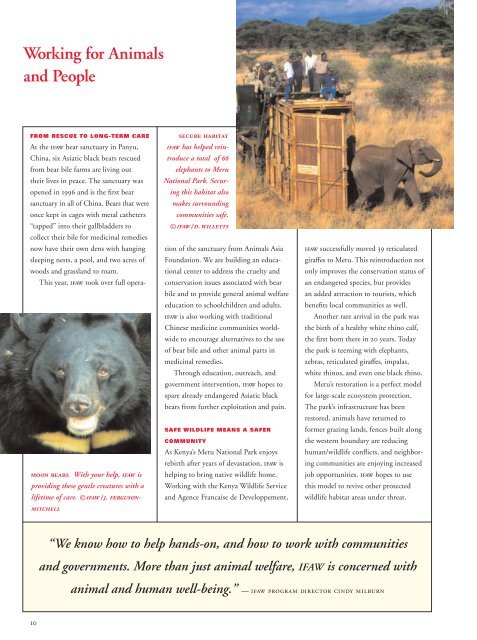Annual Report 2003.pdf - International Fund for Animal Welfare
Annual Report 2003.pdf - International Fund for Animal Welfare
Annual Report 2003.pdf - International Fund for Animal Welfare
You also want an ePaper? Increase the reach of your titles
YUMPU automatically turns print PDFs into web optimized ePapers that Google loves.
Working <strong>for</strong> <strong>Animal</strong>s<br />
and People<br />
FROM RESCUE TO LONG-TERM CARE<br />
At the ifaw bear sanctuary in Panyu,<br />
China, six Asiatic black bears rescued<br />
from bear bile farms are living out<br />
their lives in peace. The sanctuary was<br />
opened in 1996 and is the first bear<br />
sanctuary in all of China. Bears that were<br />
once kept in cages with metal catheters<br />
“tapped” into their gallbladders to<br />
collect their bile <strong>for</strong> medicinal remedies<br />
now have their own dens with hanging<br />
sleeping nests, a pool, and two acres of<br />
woods and grassland to roam.<br />
This year, ifaw took over full opera-<br />
moon bears With your help, ifaw is<br />
providing these gentle creatures with a<br />
lifetime of care. © ifaw/j. fergusonmitchell<br />
10<br />
secure habitat<br />
ifaw has helped reintroduce<br />
a total of 66<br />
elephants to Meru<br />
National Park. Securing<br />
this habitat also<br />
makes surrounding<br />
communities safe.<br />
© ifaw/d.willetts<br />
tion of the sanctuary from <strong>Animal</strong>s Asia<br />
Foundation. We are building an educational<br />
center to address the cruelty and<br />
conservation issues associated with bear<br />
bile and to provide general animal welfare<br />
education to schoolchildren and adults.<br />
ifaw is also working with traditional<br />
Chinese medicine communities worldwide<br />
to encourage alternatives to the use<br />
of bear bile and other animal parts in<br />
medicinal remedies.<br />
Through education, outreach, and<br />
government intervention, ifaw hopes to<br />
spare already endangered Asiatic black<br />
bears from further exploitation and pain.<br />
SAFE WILDLIFE MEANS A SAFER<br />
COMMUNITY<br />
As Kenya’s Meru National Park enjoys<br />
rebirth after years of devastation, ifaw is<br />
helping to bring native wildlife home.<br />
Working with the Kenya Wildlife Service<br />
and Agence Francaise de Developpement,<br />
ifaw successfully moved 39 reticulated<br />
gira∑es to Meru. This reintroduction not<br />
only improves the conservation status of<br />
an endangered species, but provides<br />
an added attraction to tourists, which<br />
benefits local communities as well.<br />
Another rare arrival in the park was<br />
the birth of a healthy white rhino calf,<br />
the first born there in 20 years. Today<br />
the park is teeming with elephants,<br />
zebras, reticulated gira∑es, impalas,<br />
white rhinos, and even one black rhino.<br />
Meru’s restoration is a perfect model<br />
<strong>for</strong> large-scale ecosystem protection.<br />
The park’s infrastructure has been<br />
restored, animals have returned to<br />
<strong>for</strong>mer grazing lands, fences built along<br />
the western boundary are reducing<br />
human/wildlife conflicts, and neighboring<br />
communities are enjoying increased<br />
job opportunities. ifaw hopes to use<br />
this model to revive other protected<br />
wildlife habitat areas under threat.<br />
“We know how to help hands-on, and how to work with communities<br />
and governments. More than just animal welfare, IFAW is concerned with<br />
animal and human well-being.” — ifaw program director cindy milburn

















